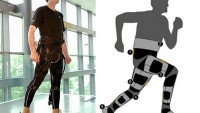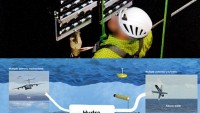DARPA Sees US Fighter Jets as First Thought-controlled Weapon
| Staff Reporter | | Jun 01, 2016 07:13 AM EDT |
(Photo : USAF) F-22 Raptor unleashes defensive flares
The U.S. Defense Advanced Projects Research Agency (DARPA) has identified the latest fifth generation U.S. fighters such as the stealthy F-22 Raptor as the first weapons to be controlled by human thought.
This advance is made possible by the recent invention of the "stentrode" by Australian scientists from the University of Melbourne. The research that led to the development of this weapon was partly funded by DARPA.
Like Us on Facebook
The size of a matchstick, the stentrode can provide the "brain-machine interface" or BMI necessary for thought-controlled devices. Neural implants currently in use require invasive surgery.
Stentrodes can be attached to the brain using catheter angiography. This procedure passes the device through blood vessels in the neck and into the brain without cutting open the skull.
Development of the minimally invasive stentrode is a key step in the widespread use of thought-controlled devices such as prosthetics and weapons.
"The military appear interested in the potential for jet fighters to control their planes with direct thought control, rather than using their arms. The reaction time you'd shave off would be milliseconds," said Dr. Tom Oxley, the University of Melbourne Neurologist whose team has been working on the stentrode for over four years.
More specifically, DARPA wants U.S. Air Force pilots to control their fighters directly by plugging their brains into the aircraft's computer, said Dr. Oxley. The stentrode will make this possible.
He said doing so will reduce piloting stress since flying computer-controlled aircraft such as the F-22 and F-35 Lightning II is physically taxing and requires the pilot evaluate and monitor several actions occurring at once. A direct BMI could reduce pilot error.
With a BMI such as the stentrode, a fighter pilot's brain will tell the muscles in the pilot's hands to take an action with the joystick when the pilot recognizes a problem.
DARPA also plans to use stentrodes to rehabilitate soldiers that have been paralyzed in combat. Electrical signals detected by the stentrode can communicate with the "soft exosuits" being developed by DARPA. Wounded soldiers will simply have to think of a movement to make it happen.
The next breakthrough, said Dr. Oxley, is direct brain-to-brain communication.
"Direct brain-to-brain telecommunication is not unfeasible 30 years from now. These devices will enable us to achieve electronic capabilities that we can't really imagine now."
There's also telepathy.
"Now imagine if that little device (the stentrode) was inside your brain and you didn't have to use your hands to type out the letters of the text message. Suddenly what you're achieving is considered telepathy," said Oxley.
TagsDefense Advanced Projects Research Agency, DARPA, F-22 Raptor, U.S. Air Force, Dr. Tom Oxley
©2015 Chinatopix All rights reserved. Do not reproduce without permission
 Aussie Tech Breakthrough Makes DARPA’s Thought-controlled Weapons a Practical Reality
Aussie Tech Breakthrough Makes DARPA’s Thought-controlled Weapons a Practical Reality DARPA Wants to Weaponize the Internet of Things to Save U.S.
DARPA Wants to Weaponize the Internet of Things to Save U.S. U.S. Spending Heavily to Counter Deadly DDoS Cyber Attacks by Foreign Foes
U.S. Spending Heavily to Counter Deadly DDoS Cyber Attacks by Foreign Foes DARPA Unveils U.S. Army Stealth Motorcycle Prototypes
DARPA Unveils U.S. Army Stealth Motorcycle Prototypes DARPA Speeds-up Work on ‘Soft Exosuit’ that will Strengthen US Soldiers
DARPA Speeds-up Work on ‘Soft Exosuit’ that will Strengthen US Soldiers DARPA’s Demo Day Reveals the Pentagon’s Secret Weapons Technology
DARPA’s Demo Day Reveals the Pentagon’s Secret Weapons Technology
EDITOR'S PICKS
-

Did the Trump administration just announce plans for a trade war with ‘hostile’ China and Russia?
-

US Senate passes Taiwan travel bill slammed by China
-

As Yan Sihong’s family grieves, here are other Chinese students who went missing abroad. Some have never been found
-

Beijing blasts Western critics who ‘smear China’ with the term sharp power
-

China Envoy Seeks to Defuse Tensions With U.S. as a Trade War Brews
-

Singapore's Deputy PM Provides Bitcoin Vote of Confidence Amid China's Blanket Bans
-

China warns investors over risks in overseas virtual currency trading
-

Chinese government most trustworthy: survey
-

Kashima Antlers On Course For Back-To-Back Titles
MOST POPULAR
LATEST NEWS
Zhou Yongkang: China's Former Security Chief Sentenced to Life in Prison

China's former Chief of the Ministry of Public Security, Zhou Yongkang, has been given a life sentence after he was found guilty of abusing his office, bribery and deliberately ... Full Article
TRENDING STORY

China Pork Prices Expected to Stabilize As The Supplies Recover

Elephone P9000 Smartphone is now on Sale on Amazon India

There's a Big Chance Cliffhangers Won't Still Be Resolved When Grey's Anatomy Season 13 Returns

Supreme Court Ruled on Samsung vs Apple Dispute for Patent Infringement

Microsoft Surface Pro 5 Rumors and Release Date: What is the Latest?










